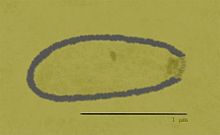闊口罐病毒屬(學名:Pithovirus)是感染變形蟲的巨型病毒,包含一個物種——西伯利亞闊口罐病毒(學名:Pithovirus sibericum),是目前已知最大的病毒。[1][2]它是一種雙鏈DNA病毒,屬於核質巨DNA病毒演化支。2014年,科學家在西伯利亞永久凍土冰芯中採集到3萬年前的可用病毒樣本之後,首次對它進行了描述。
描述
在被發現的闊口罐病毒當中,長度最高的有1.5微米,直徑則有0.5微米,因此闊口罐病毒是目前已知最大的病毒。它比此前最大的病毒——潘多拉病毒大50%。[3]闊口罐病毒厚壁呈橢圓形,其一端有一個開口。病毒內部結構和蜂巢相近。[1]
闊口罐病毒的基因組約含500個不同的基因,這比一般的病毒多,但仍比潘多拉病毒的基因組少一個數量級。[3]因此,該病毒當中的基因組的密集度比所有其他病毒種類都要低。其2/3的蛋白質都與別的病毒不同。雖然外表和潘多拉病毒相似,但基因組測序所得出的結果指出,兩種病毒在基因組成上並不接近,而闊口罐病毒其實更接近馬賽病毒科(Marseilleviridae)、巨型病毒科(Megaviridae)和虹彩病毒科的成員。[4]這些病毒都呈二十面體形,含DNA基因組。闊口罐病毒含36%GC含量,與巨型病毒科相近;潘多拉病毒的GC含量則高於61%。[5]
複製
病毒的基因組包含製造mRNA所需的所有蛋白質編碼。這些蛋白質在純病毒體中出現。[4]闊口罐病毒的整個複製週期都在其宿主的細胞質中進行。這和其他巨型DNA病毒相似,如痘病毒科[4]及巨型病毒科(潘多拉病毒除外)[5]。其他病毒一般以控制宿主的細胞核進行複製。[1][4][6]
發現
法國艾克斯-馬賽大學的尚塔爾·阿伯傑爾(Chantal Abergel)和讓-米歇爾·克拉弗里(Jean-Michel Claverie)在西伯利亞永久凍土中發現了一個3萬年前的闊口罐病毒樣本。[1]病毒埋藏在地下30米處的晚更新世沉積層。[2][4]研究人員在把變形蟲暴露在2000年採得的樣本之後,發現了這一病毒。[7]這些變形蟲開始死去,檢測發現它們內部含有巨型病毒。病毒屬的命名取自古希臘人所用的大型器皿闊口罐。參與的科學家稱,他們在兩年前了解到一項把古老狹葉蠅子草(Silene stenophylla)種子成功復活的實驗之後,決定在永久凍土中尋找新的病毒。[1]有關闊口罐病毒的研究結果刊登在《美國國家科學院院刊》中。[3][5]
雖然這一病毒對人類並沒有危害,但它在長久凍結埋藏後仍能復活,使人們擔心全球氣候變化和鑽探凍土層可能會帶出未知、有害的病毒。[3]
參見
參考資料
- ^ 1.0 1.1 1.2 1.3 1.4 Yong, Ed. Giant virus resurrected from 30,000-year-old ice : Nature News & Comment. Nature. 3 March 2014. doi:10.1038/nature.2014.14801.
- ^ 2.0 2.1 Morelle, Rebecca. 30,000-year-old giant virus 'comes back to life'. BBC News. 3 March 2014 [2014-03-05]. (原始内容存档于2017-12-28).
- ^ 3.0 3.1 3.2 3.3 Sirucek, Stefan. Ancient "Giant Virus" Revived From Siberian Permafrost. National Geographic. 3 March 2014 [2014-03-05]. (原始内容存档于2018-06-25).
- ^ 4.0 4.1 4.2 4.3 4.4 Racaniello, Vincent. Pithovirus: Bigger than Pandoravirus with a smaller genome. Virology Blog. 4 March 2014 [2014-03-05]. (原始内容存档于2017-11-07).
- ^ 5.0 5.1 5.2 Matthieu Legendre, Julia Bartoli, Lyubov Shmakova, Sandra Jeudy, Karine Labadie, Annie Adrait, Magali Lescot, Olivier Poirot, Lionel Bertaux, Christophe Bruley, Yohann Couté, Elizaveta Rivkina, Chantal Abergel, Jean-Michel Claverie. Thirty-thousand-year-old distant relative of giant icosahedral DNA viruses with a pandoravirus morphology. Proceedings of the National Academy of Sciences. 2014-03-18, 111 (11): 4274–4279 [2018-04-02]. doi:10.1073/pnas.1320670111. (原始内容存档于2019-07-13).
- ^ Coghlan, Andy. Biggest-ever virus revived from Stone Age permafrost. NewScientist. 3 March 2014 [2014-03-05]. (原始内容存档于2014-03-05).
- ^ Zimmer, Carl. Out of Siberian Ice, a Virus Revived. The New York Times. 3 March 2014 [2014-03-05]. (原始内容存档于2020-12-13).
